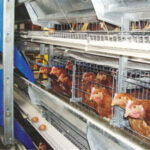Management Points for Efficient Feeding of Chicks
Chicks usually start eating 24 to 26 hours after hatching. After the food is opened, the feed such as millet and crushed corn can be sprinkled on a red or green plastic cloth to allow the chicks to forage. After 3 days, they are gradually replaced with compound feed.
Maintaining a suitable temperature for the brooding room is an important condition for successful brooding. Poultry farming equipment manufacturers of layer cages for sale can advise you that chicks are suitable for living at a relative humidity of 60 to 65%. If the humidity in the brooding room is too large, you can change the litter frequently, do not let the drinking water wet the grass, and also reduce the humidity by strengthening the indoor ventilation; if the humidity is too small, you can boil water on the heat source or sprinkle water on the sidewalk. Humidification.

In chicks 1 to 2 days old, 24-hour all-weather light can be used to familiarize the chicks so that they can eat and drink. However, the illumination should not be too bright, and it is generally appropriate to install a light bulb of 25W per 20 square meters.
The breeding density of the brooding room should not be too large in your poultry farming equipment. It is generally appropriate to raise about 20 chicks of 1 to 7 days old per square meter. Later, as the age increases, the number of breeding is gradually reduced. If the breeding density is too large in the brooding room, it will not only cause the growth and development of the chicks, but also increase the incidence rate, and increase the mortality rate and the residual rate, thus reducing the feeding efficiency.









